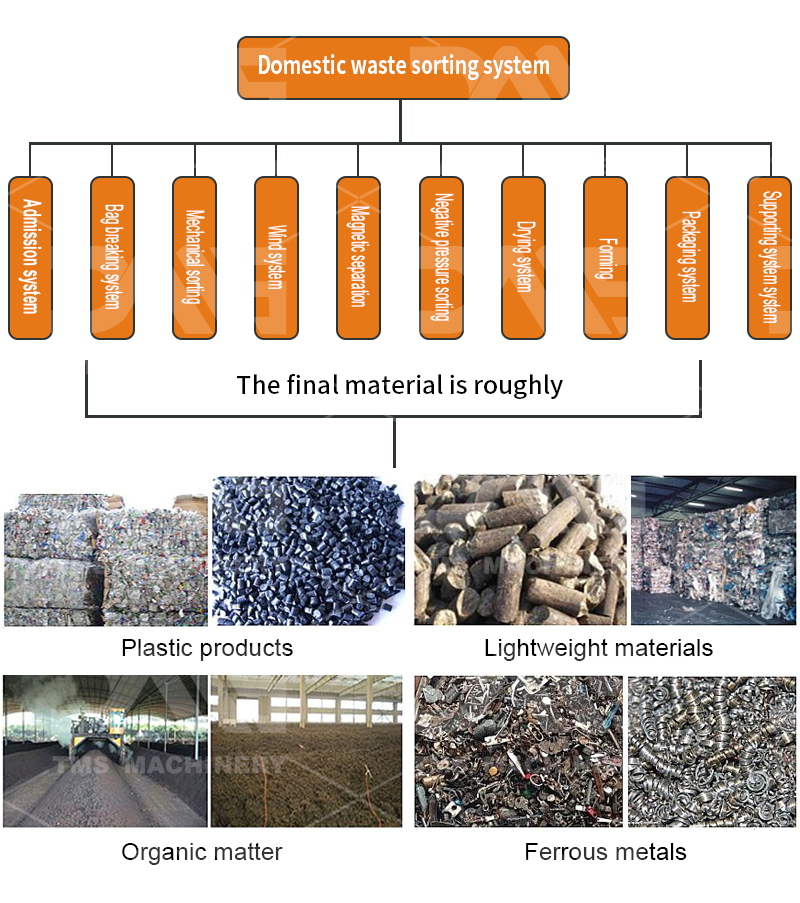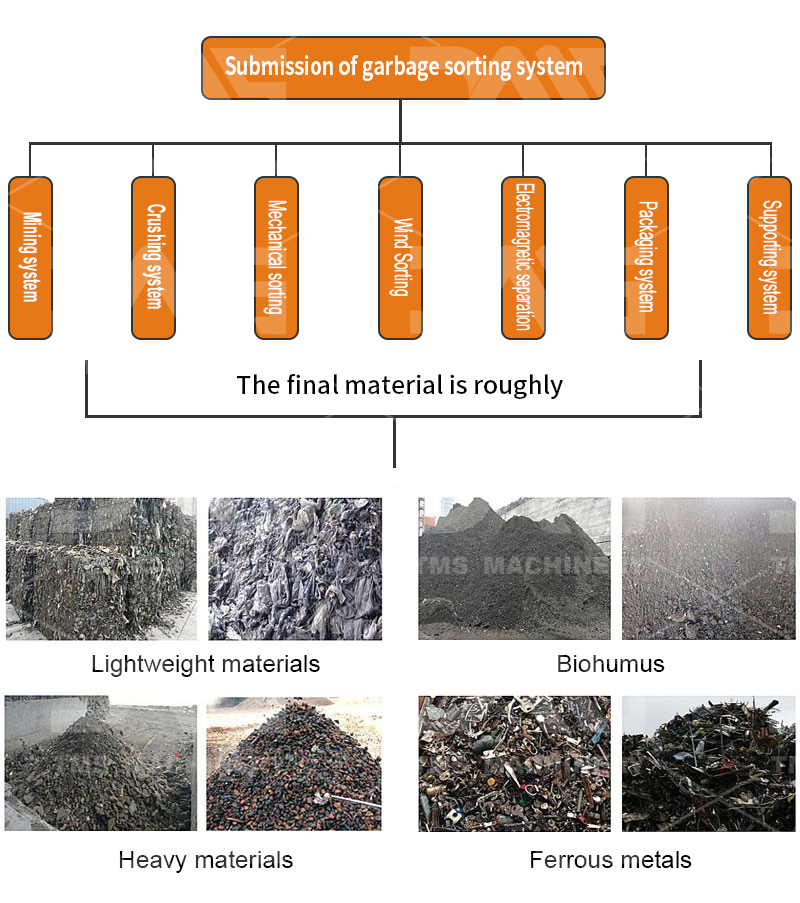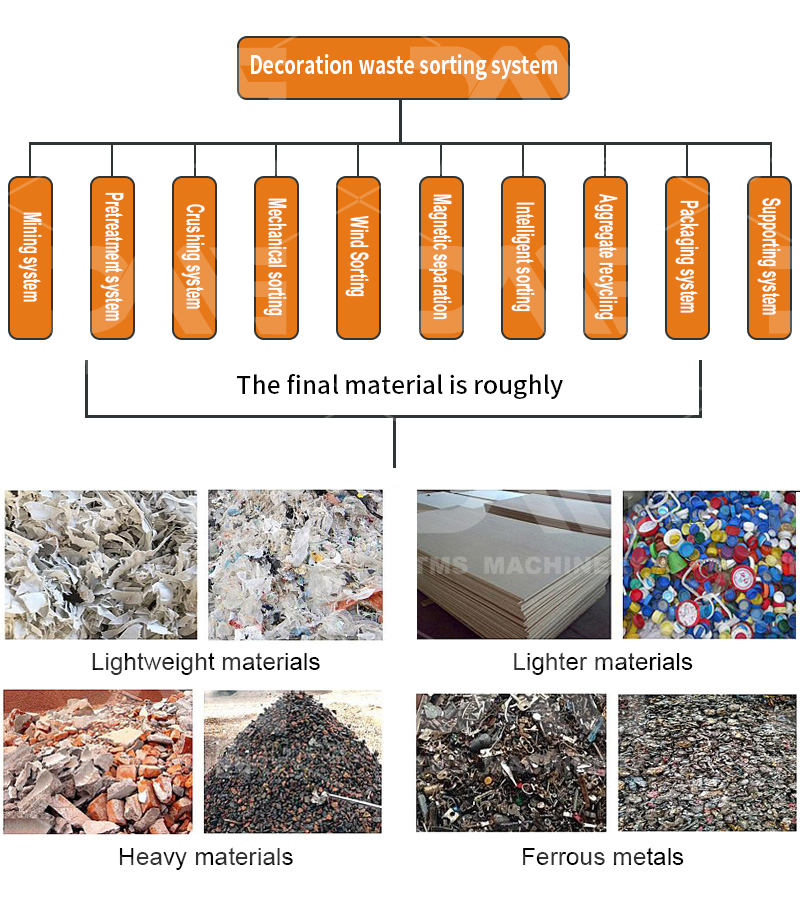Garbage and solid waste separation refers to the separation of different components in mixed solid waste by physical, chemical or biological methods, so as to facilitate subsequent resource utilization, harmless treatment or disposal.
Classification of garbage and solid waste equipment:
Domestic waste treatment equipment, decoration waste treatment equipment, comprehensive waste treatment equipment, stale waste treatment equipment, domestic waste treatment equipment, construction waste treatment equipment.
Introduction to domestic waste sorting equipment:
Fully enclosed, mechanized waste sorting equipment, also known as waste sorting equipment and waste sorting and processing equipment, is mainly used for waste sorting. Waste can be sorted into six categories: one is inorganic matter (such as bricks and tiles), which can be made into building materials after being selected; the second is non-recyclable combustibles, which enter the pyrolysis gasification system to provide heat energy; the third is organic matter and sandy soil, which are naturally fermented to make nutrient soil or organic fertilizer; the fourth is plastic type, which is used to make wood-plastic boards or plastic particles; the fifth is ferromagnetic materials, which are mainly recycled. The above 6 types of materials enter the corresponding treatment system respectively to achieve comprehensive treatment of urban domestic waste.
The waste sorting equipment consists of a garbage storage bin and hoisting and feeding, crushing, screening, air separation, specific gravity separation, magnetic separation, and transportation. It sorts various types of garbage into different types of recycled materials such as inorganic matter, organic matter, combustibles, plastics, and ferromagnetic materials, and sends them to the next system for harmless comprehensive treatment and cross-recycling of resources.

Working process of garbage sorting equipment:
Step 1: The garbage enters the manual sorting platform, and large objects such as large furniture, clothes, bottles, large pieces of glass, and a small amount of construction waste are picked out manually. On the one hand, the utilization rate of waste is expanded, and on the other hand, the piles of subsequent steps are reduced. After primary crushing, it enters the next step of sorting.
Step 2: After completing the above steps, the garbage entering the screening system is divided into two sizes. One is larger objects such as plastics and shoes, and the other is smaller objects that enter the eddy current separator to obtain metals, and the remaining materials are synthesized into fertilizers or nutrient soil.
Step 3: The oversized objects that have been screened will be separated again by gravity separation (wind separation equipment) to obtain some lighter objects (mostly plastics) and other heavier objects. The heavy objects enter the eddy current separator to obtain metal and organic waste, and the lighter ones will be packaged by the baler.
Introduction to stale garbage sorting equipment:
Garbage sorting equipment is a series of processes such as conveyors, air separators, rollers, magnetic vortex separators, air separation, dust collection and gas treatment. The copper, aluminum and non-ferrous metals, iron and magnetic materials, plastics and rubber, stainless steel, heavy sand and gravel, organic matter and debris, large clothes and other materials in the original materials are separated. The purity can reach about 98%. The process is fully automated from feeding to sorting. It can process 100-500 tons per day and only requires a small amount of manual operation. The whole set of equipment does not require burning, chemical raw materials, and water. It is an environmentally friendly recycling project advocated by the country, replacing the original manual, burning, water selection or landfill and other pollution methods. It is mainly used for the extraction and sorting of recyclable materials in urban domestic garbage, industrial garbage, construction waste, decoration waste, stale garbage and other garbage.

Working process of stale garbage sorting equipment:
Step 1: Load the landfill garbage into the sorting equipment and store it in the waste dump area. Use a forklift or a truck to put the garbage into the feed hopper and then transfer it to the balanced feeder through the plate feeder to initially crush the packed garbage. The balanced feeder evenly transfers the waste to the next step.
Step 2: The garbage enters the manual sorting platform, and large objects such as large furniture, clothes, bottles, large pieces of glass, and a small amount of construction waste are picked out manually. On the one hand, the utilization rate of waste is expanded, and on the other hand, the piles of subsequent steps are reduced. After primary crushing, it enters the next step of sorting.
Step 3: After completing the above steps, the garbage entering the screening system is divided into two sizes. One is larger objects such as plastics and shoes, and the other is smaller objects that enter the eddy current separator to obtain metals, and the remaining materials are synthesized into fertilizers or nutrient soil.
Step 4: The oversized objects that have been screened will be separated again by gravity separation (wind separation equipment) to obtain a part of lighter objects (mostly plastics) and other heavier objects. The heavy materials enter the eddy current separator 2 to obtain metal and organic waste, and the lighter materials will be baled by the baler.
Introduction to decoration waste sorting equipment:
Waste sorting equipment is a series of processes such as conveyors, air separators, rollers, magnetic vortex separators, air separation, dust collection and gas treatment. Copper, aluminum and non-ferrous metals, iron and magnetic materials, plastics and rubber, stainless steel, heavy sand and gravel, organic matter and sundries, large clothes and other materials in the original materials are sorted separately. The purity can reach about 98%. The process is fully automated from feeding to sorting, with a daily processing capacity of 300-500 tons and only a small amount of manual operation. The whole set of equipment does not require burning, chemical raw materials, and water. It is an environmentally friendly recycling project advocated by the country, replacing the original manual, burning, water selection or landfill and other pollution methods. It is mainly used for the extraction and sorting of recyclable materials in urban domestic waste, industrial waste, construction waste, decoration waste, stale waste and other waste.

Introduction to construction waste sorting equipment:
Construction waste treatment and recycling is a way to solve the problem of urban construction waste siege, which has both economic and social benefits. In the process of treatment, the crushing station plays an extremely important role because of its convenience, speed and high efficiency.
Construction waste sorting station equipment composition
Vibrating feeder, disc screen, belt conveyor, circular vibrating screen, air separator, drum screen, iron remover, light material baler and other parts.

Application of construction waste sorting station equipment:
1) After the process flow of the construction waste resource treatment system has been improved, the brick-concrete construction waste is mainly removed by vibrating screens
2) After crushing with a crusher, the steel bars can be removed by magnetic separation equipment; 3) The materials are transported to the separator, and then the bricks and concrete are directly separated, and they are respectively processed in different production lines, 4) After the primary aggregate of the concrete is crushed again by the crusher, it is transported to the vibrating screen by a belt conveyor, and the aggregate is output according to different particle sizes through screening.
5) The aggregate is then transported to the particle shaping equipment for shaping, and then the dust is removed by a dust collector to output the finished material. According to the composition of construction waste, a reasonable treatment process is adopted to achieve the recycling of construction waste and coordinate the development of economy and environmental protection.